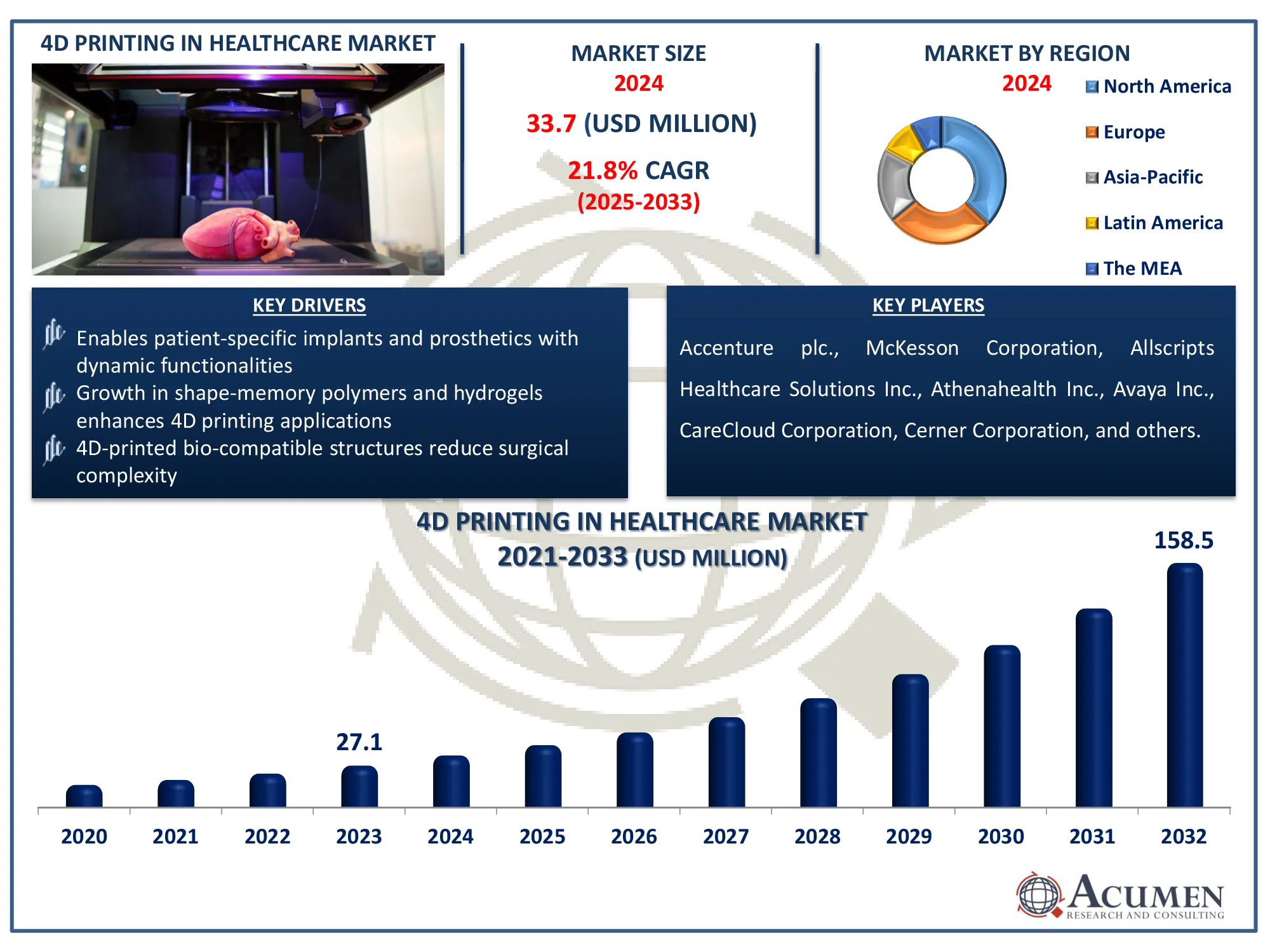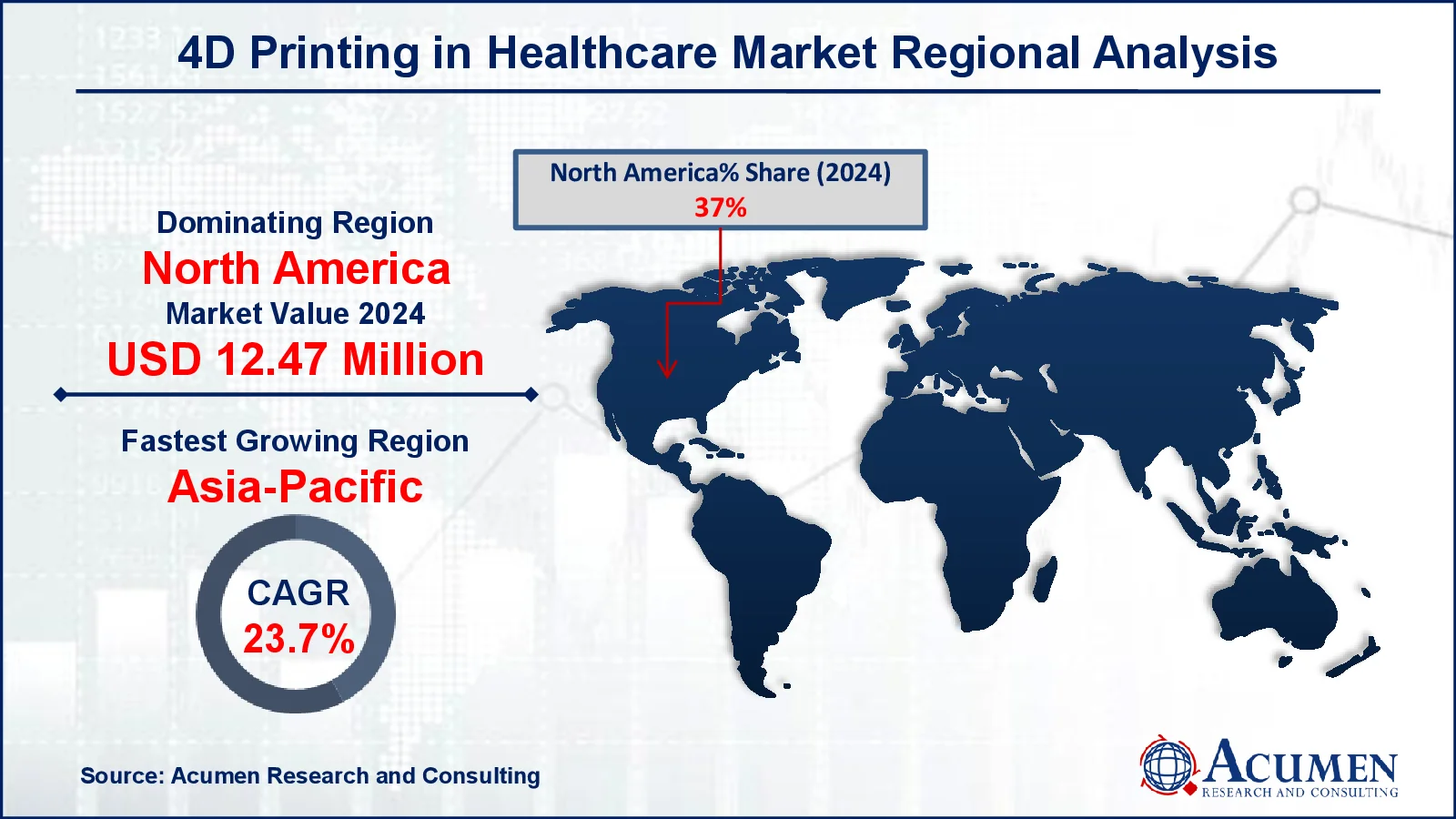January 2025
The Global 4D Printing in Healthcare Market Size accounted for USD 33.7 Million in 2024 and is estimated to achieve a market size of USD 195.6 Million by 2033 growing at a CAGR of 21.8% from 2025 to 2033.
The Global 4D Printing in Healthcare Market Size accounted for USD 33.7 Million in 2024 and is estimated to achieve a market size of USD 195.6 Million by 2033 growing at a CAGR of 21.8% from 2025 to 2033.

4D printing is an emerging technology that has the potential to alter the artificial organs and prosthetics business. 4D printing, created through cooperation between MIT's Lab and Stratasys, improves standard 3D printing by integrating time as the fourth dimension, allowing printed items to alter shape over time. One significant benefit of this breakthrough is that 3D-printed objects can be updated even after manufacturing, allowing for personalized prosthetics and artificial organs adapted to a patient's physiology. While 4D printing has enormous potential in healthcare, more research is needed to understand its entire spectrum of uses. Researchers have found intriguing applications in chemotherapy, tissue engineering, and self-assembling biomaterials.
|
Market |
4D Printing in Healthcare Market |
|
4D Printing in Healthcare Market Size 2024 |
USD 33.7 Million |
|
4D Printing in Healthcare Market Forecast 2033 |
USD 195.6 Million |
|
4D Printing in Healthcare Market CAGR During 2025 - 2033 |
21.8% |
|
4D Printing in Healthcare Market Analysis Period |
2021 - 2033 |
|
4D Printing in Healthcare Market Base Year |
2024 |
|
4D Printing in Healthcare Market Forecast Data |
2025 - 2033 |
|
Segments Covered |
By Component, By Technology, By Application, By End-User, and By Geography |
|
Regional Scope |
North America, Europe, Asia Pacific, Latin America, and Middle East & Africa |
|
Key Companies Profiled Aviation |
Accenture plc., McKesson Corporation, Allscripts Healthcare Solutions Inc., Athenahealth Inc., Avaya Inc., CareCloud Corporation, Cerner Corporation, Cognizant Technology Solutions Corporation, eClinicalWorks LLC, GE Healthcare, Genpact Limited, and IBM Corporation. |
|
Report Coverage |
Market Trends, Drivers, Restraints, Competitive Analysis, Player Profiling, Covid-19 Analysis, Regulation Analysis |
The wide range of applications, the growing need for organ transplants, and the benefits associated with 4D technology are the primary drivers of the 4D printing market in healthcare. For example, the technology can produce implants as designed that can grow with the patient. Furthermore, it reduces the need for surgical procedures by creating self-deforming components that may treat any defect in the body. 4D printing technology is also valuable in research studies because it allows for product innovation during the design and development stage.
The availability of financing and scientists' increased interest in this new technology are driving an increase in research publications on the subject. For example, in October 2024, the IISc team created nanoengineered hydrogel ink for 4D printing. A team of experts from the Department of Materials Engineering and Bioengineering at the Indian Institute of Science in Bengaluru used this approach to create artificial blood arteries. However, some of the market's limiting issues include expensive development costs, little awareness in low and middle-income nations, and severe regulatory regulations for implantable devices and smart materials used in the product.
Furthermore, in July 2023, researchers at Queen's University Belfast developed tailored 4D-printed "smart" implants for breast cancer care. These versatile implants alter size to fit better within the breast cavity, resulting in a more personalized fit for each individual. This improves the aesthetic and confidence outcomes for persons with or who have had breast cancer. This accomplishment demonstrates the potential of 4D printing in personalized medicine, creating a substantial opportunity for the expansion of the 4D printing in healthcare market.
 4D Printing in Healthcare Market Segmentation
4D Printing in Healthcare Market SegmentationThe worldwide market for 4D printing in healthcare is split based on component, technology, application, end-user, and geography.
According to 4D printing in healthcare industry analysis, in 2024, the software and services segment emerged as the dominant force, owing to the crucial significance of advanced design, simulation, and modeling tools in developing complicated, patient-specific medical solutions. Furthermore, the growing need for customization in prostheses, implants, and drug delivery systems has increased the need for specialist services such as consultation, design optimization, and post-printing changes. The increasing integration of AI and machine learning into 4D printing software has improved predictive modeling and efficiency, making this area critical to the wider use of 4D printing in healthcare.
According to 4D printing in healthcare industry analysis, FDM technology held the greatest market share in 2024. This can be due to its capacity to construct a mechanically robust model. However, the polyjet segment is expected to grow the fastest throughout the forecast period, as this technology allows for the creation of delicate and complicated structures. It can also create objects with several materials and colors in a single model. Polyjet technology's other significant features, such as little waste and high accuracy, are driving market demand.
According to 4D printing in healthcare sector analysis, the medical research model sector dominated the market, due to continuous research. These models can be adjusted to match the patient's physiology. Researchers used 4D-printed models to track illness development, test treatment efficacy, and design dynamic, patient-specific anatomical structures for pre-surgical planning. The ability of these models to change shape and function over time has greatly increased biomedical research, resulting in better healthcare outcomes and the expansion of 4D printing applications.
According to 4D printing in healthcare market forecast, hospitals are likely to dominate the industry as important end users due to their increasing adoption of personalized medical solutions such as self-adaptive implants, prosthetics, and drug delivery systems. The use of 4D printing allows hospitals to improve patient care by providing personalized therapies, improving surgical precision, and shortening recuperation times. Furthermore, the capacity to manufacture on-demand, shape-shifting medical equipment within hospital settings reduces dependent on external suppliers, driving efficiency and cost-effectiveness in healthcare services.
North America
Europe
Asia-Pacific
Latin America
The Middle East & Africa
 4D Printing in Healthcare Market Regional Analysis
4D Printing in Healthcare Market Regional AnalysisIn terms of regional segments, North America held the largest share of the worldwide healthcare 4D printing market, and it is predicted to increase significantly in the future as a result of ongoing technical advances in the sector. Furthermore, increased demand for organ transplantation and a scarcity of organ donors are expected to drive the regional market throughout the forecast period. For example, OrganDonor.gov reports that 103,223 men, women, and children are on the national transplant waiting list. 17 individuals die every day while waiting for an organ transplant. More than 48,000 transplants were performed in 2024. Other major drivers for the region's dominance include high investment by market players in the production of 4D models, as well as the presence of advanced healthcare infrastructure for the development and implementation of 4D models.
Asia-Pacific is experiencing rapid growth in 4D printing in the healthcare industry. According to data from the National Organ Tissue and Transplant Organization, the number of registered patients on the waiting list for organ transplants climbed from 2,833 in 2021 to 3,275 in 2022. In 2022, the country saw a total of 15,561 organ transplants. The growing number of organ transplants will fuel the expansion of 4D printing in the healthcare market in the forecast year.
Some of the top 4D printing in healthcare companies offered in our report includes Accenture plc., McKesson Corporation, Allscripts Healthcare Solutions Inc., Athenahealth Inc., Avaya Inc., CareCloud Corporation, Cerner Corporation, Cognizant Technology Solutions Corporation, eClinicalWorks LLC, GE Healthcare, Genpact Limited, and IBM Corporation.
Looking for discounts, bulk pricing, or custom solutions? Contact us today at sales@acumenresearchandconsulting.com
January 2025
March 2025
January 2025
September 2023